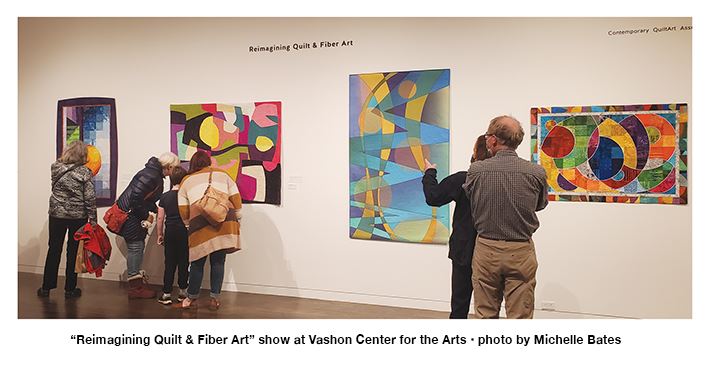 A short ferry ride away from the mainland, Vashon’s vibrant visual arts scene keeps strutting its stuff in high style.
A short ferry ride away from the mainland, Vashon’s vibrant visual arts scene keeps strutting its stuff in high style.
 Vashon has been a haven for artists since the 1960s and 70s, when an influx of young artists changed the cultural landscape of the island.
Vashon has been a haven for artists since the 1960s and 70s, when an influx of young artists changed the cultural landscape of the island.
Many of those people helped establish Vashon Allied Arts (now Vashon Center for the Arts) as the cultural linchpin of the community, as well as led numerous other arts enterprises on the island throughout the years.
Some of them are still doing it.
Case in point: Swiftwater Gallery, a brand-new, 51-member nonprofit arts’ collective, which opened in February in a prime location, 17600 Vashon Hwy. SW, in Vashon’s town center.
The gallery is the former home of Gather Vashon, a gallery that also featured local art, run by a mother-daughter team from 2018 to September of 2022.
Prior to that, the storefront was the longtime home of the Heron’s Nest Gallery, a retail gallery run by Vashon Allied Arts.
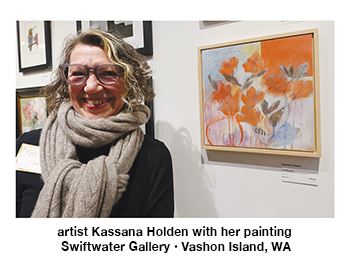 Swiftwater Gallery organizers included a number of longtime locals who had shown their work in both of those former venues—and were determined, when they first learned that Gather would close, to find a way to keep the retail space artful.
Swiftwater Gallery organizers included a number of longtime locals who had shown their work in both of those former venues—and were determined, when they first learned that Gather would close, to find a way to keep the retail space artful.
Their planning came to fruition with Swiftwater Gallery’s recent grand opening
—a packed and celebratory occasion.
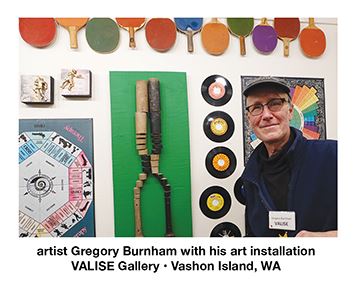 Swiftwater Gallery
Swiftwater Gallery
On a recent afternoon, volunteer gallery manager and photographer, Kim Farrell, and collective member artist, Charlotte Masi, worked the well-lit gallery, which was filled with a variety of art by all the collective’s members.
Swiftwater Gallery opens new rotating exhibits on the First Friday of every month, when Vashon Island holds its monthly Gallery Cruise—a longstanding evening art stroll through shops, galleries and eateries. Find out more at swiftwatergallery.com.
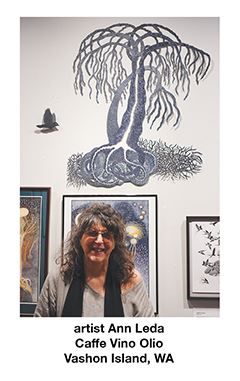 But wait, there’s more…
But wait, there’s more…
Vashon’s main street boasts not one but two galleries run by artists’ collectives — VALISE Gallery, Vashon Artists Linked in Social Engagement, has been around since 2009, at 17633 Vashon Hwy. SW.
VALISE Gallery
In February, VALISE pranked islanders by plastering the gallery’s windows with posters advertising a new business: Zamfir’s, a pawn shop/smoke shop. But some islanders with long memories got the joke: when VALISE opened, 14 years ago, the same posters and signage were on display. Zamfir’s is part of the gallery’s origin story, said Jiji Saunders, of VALISE, and throughout the years, the gallery has mounted several exhibitions that touch on its recurring conceptual themes of high and low commerce.
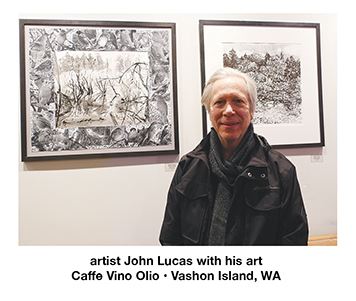 In March, VALISE hosts an invitational of 13 island artists who have never before shown their work at the gallery. In April, the exhibit, “Extra Cheese, Please,” features collective members creating art out of pizza boxes from O Sole Mio — a New York-style pizza joint just down the street from the gallery. Find out more at valisegallery.com.
In March, VALISE hosts an invitational of 13 island artists who have never before shown their work at the gallery. In April, the exhibit, “Extra Cheese, Please,” features collective members creating art out of pizza boxes from O Sole Mio — a New York-style pizza joint just down the street from the gallery. Find out more at valisegallery.com.
The Hardware Store Restaurant Gallery
A historic island building, on the corner of Bank Road and Vashon Highway, now houses an Americana restaurant—the food is tasty, but don’t miss the gallery tucked in the back of the restaurant, featuring exhibits of the work of local artists that rotate monthly.
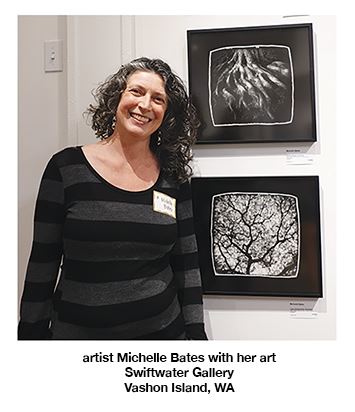 Caffe Vino Olio
Caffe Vino Olio
A stylish wine, coffee, and bagel shop next to The Hardware Store Restaurant also boasts an art spot, tucked into the back of the space. Works by local artists fill its walls each month.
Starving
Artists Works
Also in downtown Vashon, tucked away in a storefront at 9922 SW Bank Road, you’ll find Starving Artists Works (SAW)—a small shop stuffed with an abundance of work by local artists and artisans. Visit the gallery’s Facebook page, or call (206) 979-4192 to find out hours.
Vashon Farmers Market
A bustling marketplace on Saturdays, from April to October, typically includes work by local artisans. The market is in the town center, at 17519 Vashon Hwy SW. Visit vigavashon.org/market.
 Vashon Center for the Arts
Vashon Center for the Arts
Any day trip to Vashon should probably begin and end at Vashon Center for the Arts (VCA)—a gleaming new performing and visual arts space that opened in 2018.Curatorially, the gallery runs the gamut of exhibits by local, regional, and national artists, with themes that range from delightfully decorative to blisteringly political. At times, they’re just dazzling, as was the case last fall, when the gallery was filled with a retrospective of the work of world-renowned cartoonist, Jim Woodring, who happens to be a Vashon resident.
In March, the VCA hosts an invitational juried show, “Choice,” prompted by the shocking reversal of Roe vs. Wade by the Supreme Court last year. The 30 works on view include “Where are you From,” by Fumi Amano—an interactive sculpture of a uterus that gallery-goers can climb inside. In April, VCA celebrates Earth Month with an exhibit of new works by tile artist Clare Dohna, a large curtain installation made of twigs by Terri Fletcher, and printmaking by Vanessa Lanza. Find out more at vashoncenterforthearts.org.
All this, and studio tours…
Visit the website of Vashon Island Visual Artists (ViVA) at vivartists.com, and mark your calendar for the membership organization’s two annual studio tours. The spring tour takes place May 6-7 and 13-14, at approximately 40 artists’ studios and galleries on Vashon Island.
Elizabeth Shepherd
Elizabeth Shepherd is the editor of The Vashon-Maury Island Beachcomber, the town’s newspaper of record.